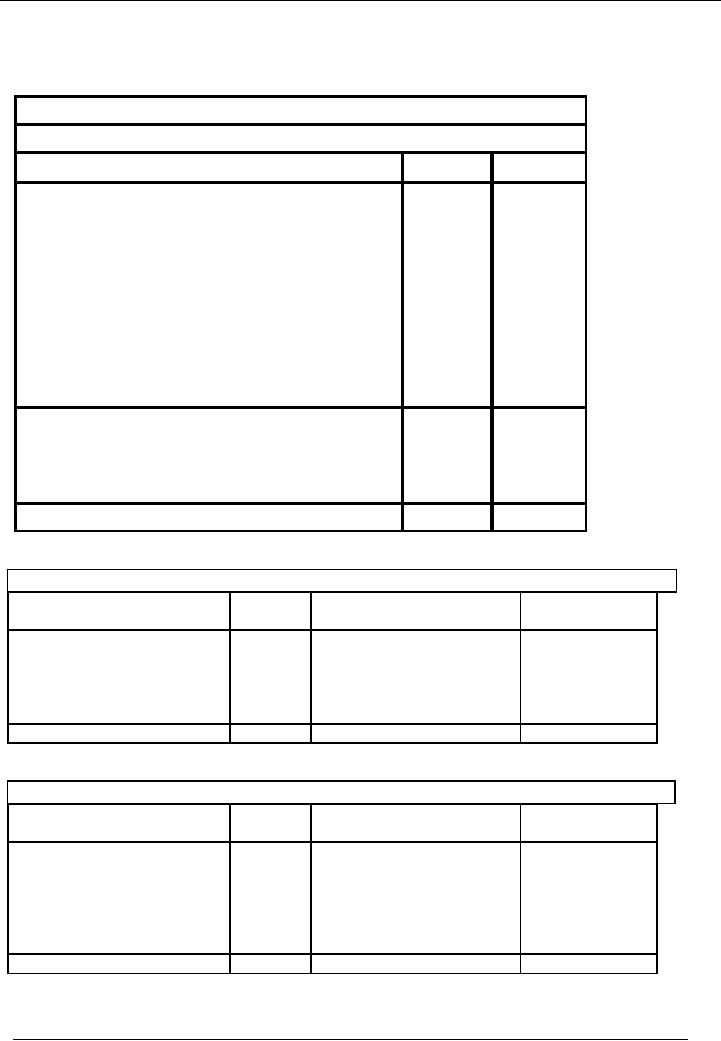 |
INTEREST ON CAPITAL AND DRAWINGS |
| << Financial Statements of Partnership firms |
| DISADVANTAGES OF A PARTNERSHIP FIRM >> |

Financial
Accounting (Mgt-101)
VU
Lesson-35
INTEREST
ON CAPITAL AND DRAWINGS
The
partnership agreement may include one or
both of the following
clauses:
o
o Partners
are charged interest on
drawings (this may be on the total amount
of the current
account
balance or on the amount exceeding a
specific limit, depending upon the
terms of
agreement).
o Partners
are given interest on their
capital (again this can be on the
total amount of the
capital
or the amount exceeding a specific
figure).
REASONS
FOR INTEREST ON
CAPITAL
The
profit/loss sharing ratio
may not be equal despite the
fact that partners have
contributed equal
o
capital,
depending upon the partnership
agreement.
Take
the following example:
o
o Two
partners start a business
and contribute equal capital
and decide to share equal
profits.
o But
they also realize that in
future the business may need
further capital and at that
time
both
partners may not be able to
contribute equally.
o So,
instead of revising the contract every time, they
include a clause in the agreement,
whereby,
the partners are allowed an interest on
the capital contributed.
o This
interest can be on the whole amount of
both partners or only of one
partner on the
amount
contributed in excess of the other
partner.
o This
way a partner, who provides capital in
excess of his profit sharing
ratio, can be
compensated.
o One
may say that the same
results can be achieved by
saying that profit and
loss sharing will
be
proportionate to the amount of capital
invested.
o But,
as we have said that in partnership
everything depends on the Partnership
Agreement.
REASONS
FOR INTEREST ON
DRAWINGS
Drawings
are opposite to capital invested
i.e. these are the funds drawn by
partners from the
o
business.
Therefore, in
order to keep the distribution of
profit fair, a clause may be
inserted in the agreement,
o
where
an interest is charged on the drawings of
the partners.
Again,
this can be on the total amount or on an amount
exceeding a specific
limit.
o
Both
of the above things depend upon the
agreement between
partners.
o
ACCOUNTING
TREATMENT
One
may think that as Interest
on Capital is paid to the partners, so it should be
treated as business
o
expense
and Interest on Drawings is charged
from the partners, therefore, it should be
treated as
income.
But
this is not the case.
o
Just
like partners salaries, both
these items will be included in the
Profit and Loss
Appropriation
o
Account.
Partners'
salaries, interests etc. are
never treated as expense or
income of the business. They
are a
o
part
of DISTRIBUTION OF PROFIT.
EXCEPTIONS
235

Financial
Accounting (Mgt-101)
VU
Rent
paid to partner for use of his
premises, purchase of stocks,
assets or other items for
use in
o
business,
Markup on loan from partner are the
exceptions. All these
expenses are charged
to
profit
& loss account of the partnership
firm.
ACCOUNTING
ENTRIES
Interest
on Capital
o
Debit:
Profit
and Loss Appropriation
Account
Credit:
Partner
A's Current Account
Credit:
Partner
B's Current Account
Credit:
Partner
C's Current Account
Interest
on Drawings
o
Debit:
Partner
A's Current Account
Debit:
Partner
B's Current Account
Debit:
Partner
C's Current Account
Credit:
Profit
and Loss Appropriation
Account
Example
# 1
Mr.
Abid is a partner in a partnership firm.
His capital on July 1, 2001
was Rs. 200,000. He invested
further
capital
of Rs. 100,000 on March 1,
2002.
You
are required to calculate his
mark up. Mark up rate is 5%.
The financial year is from
July to June.
SOLUTION
Rs.
200,000 was invested in the
beginning of the year and
extra capital was invested
on 1st March. So,
from
March
onward, the capital is Rs. 300,000
(200,000 + 100,000). We will
calculate mark up on Rs.
200,000 for
12
months, i.e., from July to
June. Mark up on 100,000
will be for 4 months, i.e.,
from March to June.
Mark
up is calculated as follows:
200,000
x 5% = 10,000
=
10,000.00
100,000
x 5% = 15,000 x 4/12 =
1666.67
Total
Mark Up
11,666.67
236

Financial
Accounting (Mgt-101)
VU
Example
# 2
Mr.
Naeem is a partner in a partnership firm. He
drew following amount during the
financial year:
Rs.
September
1
3,000
November
1
5,000
January
1
4,000
March
1
5,000
June
1
2,000
You
are required to calculate Mark up on
his drawings, if the rate of
mark up is 5%. The financial year
is
from
July to June,
SOLUTION
3,000
x 5% = 150 x 10/12 =
125.00
5,000
x 5% = 250 x 8/12 =
166.67
4,000
x 5% = 200 x 6/12 =
100.00
5,000
x 5% = 250 x 4/12 =
83.33
2,000
x 5% = 100 x 1/12 =
8.33
Total
Mark Up
483.33
EXAMPLE
# 3
Atif,
Babar and Dawar are
three partners sharing
profits equally.
You
are required to prepare profit
and loss appropriation
account and extract from
balance sheet,
showing
partners
capital and current accounts
from the following
information:
·
Net
profit for the year Rs.
558,000
·
Opening
balance of Capital accounts Atif
Rs. 500,000, Babar Rs.
600,000, Dawar Rs.
400,000
·
Opening
balance of Current Account Atif
Rs. 55,800, Babar Rs.
63,820, Dawar Rs.
20,555.
·
Salaries
to be paid to Babar Rs. 10,000,
Dawar Rs. 12,000.
·
Drawings
during the year Atif Rs.
180,000, Babar Rs. 220,000
Dawar Rs. 151,000
·
Mark
up on Capital @ 5% and Mark up on
drawings are: Atif Rs.
9,000, Babar Rs. 11,000
and
Dawar
Rs. 7,550.
237

Financial
Accounting (Mgt-101)
VU
SOLUTION
PROFIT
& LOSS APPROPRIATION
ACCOUNT
Atif,
Babar, Dawar & Co
Profit
Distribution Account
Particulars
Note
Amount
Rs. Amount Rs.
Net
Profit
558,000
Less:
Partner's Salary
Babar
10,000
Dawar
12,000
(22,000)
Less:
Interest on capital Atif (5% of
500,000)
25,000
Babar
(5% of 600,000)
30,000
Dawar(5% of
400,000)
20,000
(75,000)
Add:
Interest on Drawings Atif
9,000
Babar
11,000
Dawar
7,550
27,550
Distributable
Profit
488,550
Less:
Partner's Share in
Profit
Atif
(1/3of 488,550)
162,850
162,850
Amir
(1/3 of 488,550)
Babar
(1/3 of 488,550)
162,850
(488,550)
0
Atif's
Current Account
Account
Code --------
Particulars
Amount
Particulars
Amount
Dr.
(Rs.)
Cr.
(Rs.)
Drawings
180,000
Opening Balance
55,800
Interest
on Drawings
9,000
Interest on Capital
25,000
Profit
for the year
162,850
Balance
c/d
54,650
Total
243,650
Total
243,650
Babar's
Current Account
Account
Code --------
Particulars
Amount
Particulars
Amount
Dr.
(Rs.)
Cr.
(Rs.)
Drawings
220,000
Opening Balance
63,820
Interest
on Drawings
11,000
Salary
10,000
Interest
on Capital
30,000
Profit
for the year
162,850
Balance
c/d
35,670
Total
266,670
Total
266,670
238

Financial
Accounting (Mgt-101)
VU
Dawar's
Current Account
Account
Code --------
Particulars
Amount
Particulars
Amount
Dr.
(Rs.)
Cr.
(Rs.)
Drawings
151,000
Opening Balance
20,555
Interest
on Drawings
7,550
Salary
12,000
Interest
on Capital
20,000
Profit
for the year
162,850
Balance
c/d
56,855
Total
215,405
Total
215,405
ADMISSION
OF A PARTNER
When a
new partner join the business,
old agreement of partnership is modified
or a new agreement is
prepared.
This new agreement contains
new ratios in which partners
share profit and loss in
new set up. At
the
admission of a new partner, all the
assets and liabilities of the
old business are revalued in
order to know
the
exact worth of the business.
Goodwill of the business is also
revalued. The value (in
monetary terms) of
the
reputation of the business is called
GOODWILL. It is an intangible
asset.
DISSOLUTION
OF A FIRM
When a
partnership is dissolved, all the
liabilities of the firm are paid,
out of the assets of the firm,
available
at the time of
dissolution. The remaining amount after paying all the
liabilities, if available, will be
distributed
among
the partners in their profit
loss sharing ratios. If
assets of the firm are not
sufficient to pay all
the
liabilities
of the firm, the partners will
contribute the balance amount in their
profit/loss sharing ratios
to
meet
the liabilities of the firm.
239
Table of Contents:
- Introduction to Financial Accounting
- Basic Concepts of Business: capital, profit, budget
- Cash Accounting and Accrual Accounting
- Business entity, Single and double entry book-keeping, Debit and Credit
- Rules of Debit and Credit for Assets, Liabilities, Income and Expenses
- flow of transactions, books of accounts, General Ledger balance
- Cash book and bank book, Accounting Period, Trial Balance and its limitations
- Profit & Loss account from trial balance, Receipt & Payment, Income & Expenditure and Profit & Loss account
- Assets and Liabilities, Balance Sheet from trial balance
- Sample Transactions of a Company
- Sample Accounts of a Company
- THE ACCOUNTING EQUATION
- types of vouchers, Carrying forward the balance of an account
- ILLUSTRATIONS: Ccarrying Forward of Balances
- Opening Stock, Closing Stock
- COST OF GOODS SOLD STATEMENT
- DEPRECIATION
- GROUPINGS OF FIXED ASSETS
- CAPITAL WORK IN PROGRESS 1
- CAPITAL WORK IN PROGRESS 2
- REVALUATION OF FIXED ASSETS
- Banking transactions, Bank reconciliation statements
- RECAP
- Accounting Examples with Solutions
- RECORDING OF PROVISION FOR BAD DEBTS
- SUBSIDIARY BOOKS
- A PERSON IS BOTH DEBTOR AND CREDITOR
- RECTIFICATION OF ERROR
- STANDARD FORMAT OF PROFIT & LOSS ACCOUNT
- STANDARD FORMAT OF BALANCE SHEET
- DIFFERENT BUSINESS ENTITIES: Commercial, Non-commercial organizations
- SOLE PROPRIETORSHIP
- Financial Statements Of Manufacturing Concern
- Financial Statements of Partnership firms
- INTEREST ON CAPITAL AND DRAWINGS
- DISADVANTAGES OF A PARTNERSHIP FIRM
- SHARE CAPITAL
- STATEMENT OF CHANGES IN EQUITY
- Financial Statements of Limited Companies
- Financial Statements of Limited Companies
- CASH FLOW STATEMENT 1
- CASH FLOW STATEMENT 2
- FINANCIAL STATEMENTS OF LISTED, QUOTED COMPANIES
- FINANCIAL STATEMENTS OF LISTED COMPANIES
- FINANCIAL STATEMENTS OF LISTED COMPANIES